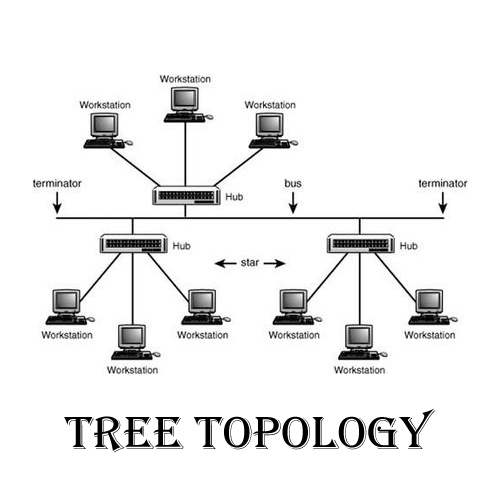Definition of tree topology
A type of network topology in which nodes are connected in such a way that it looks like a tree. Tree topology is a combination of bus topology and star topology. In a bus topology nodes are connected to the central bus. While in a star topology nodes are connected to hubs. Tree topology is an expansion of tree and bus topology. It is also known as an extended star topology.
In tree topology hubs are connected to the central bus. There is a point to point connection between every node meaning every node is connected to a hub or concentrator. To expand a tree network you just need to attach another hub and cables.

Tree topology is flexible and reliable. Tree network can be connected to large network also. This network is connected in such a way that it reduces network traffic also. You can connect as many servers to the network as you want. The information is shared among all the computers in the network. If any computer wants to send a message then it will broadcast the message through hub and the hub will redirect the message to the destination computer.
Some pros and cons of tree topology are explained below.
Advantages of tree topology
Some benefits of tree topology are:-
Bus and star combination:
Tree topology is a combination of bus and star topology. So the features of both bus and star topologies are added to the tree topology.
Expansion of network:
It is easy to expand the network. You just need an extra hub and cables. More star networks are added to the main cable or bus without any issue.
Error detection:
It is easy to identify the error in the network. As every node is connected to a hub or concentrator so the hub can detect which node has a problem in it and you can easily replace the cable or other problem with the node.
Better security:
Tree topology is connected through hub/switch and has much better security than bus and star topology.
Reliable:
If any node gets disconnected from the tree network then other nodes will function regularly. The performance of the network is not affected by removing any node.
Compatibility:
Tree topology supports a wide range of software and hardware vendors. This network is better than bus and star topology as well.
Disadvantages of tree topology
Some drawbacks of tree topology are:-
Dependent on the main bus:
Tree topology is dependent on the main bus cable. If the main bus gets any problem the whole network will fail to perform.
Scalability:
The scalability of the network depends upon the type of cable used to make the network. If the cable has poor quality then it will create a problem in expanding the network in future. The data transfer rate is also affected by the type of cable used.
Maintenance of network:
If more and more segments/nodes are added to the network then it becomes a problem to manage the network.
Cable length:
More and more cables are required to expand the network. So the length of the cable increases as the network grows and it becomes a problem to manage the cables.
Hub issue:
If any hub stops working then some nodes in the network become disconnected from the network.
Costly:
This network is more costly than bus and star topology. The length of cables and additional hub cost more money.
Examples of tree topology
- Cable TV network
- Small to medium size computer networks
- B-Trees




